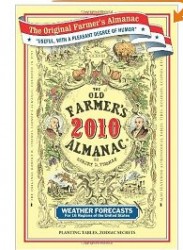By: Daniel Nardini
 The oldest publication still running in the United States today is the Old Farmers Almanac. The Old Farmers Almanac has been known to generations of Americans—both in our major cities and in small out-of-the way rural towns—for the last 220 years. To learn about the Old Farmers Almanac, I spoke with Mare-Anne Jarvela who is senior editor of the Old Farmers Almanac. The Old Farmers Almanac is the oldest continually published periodical in the United States today. The journal was first started by a man named Robert S. Thomas, a resident of Massachusetts, in 1792. The very first Old Farmers Almanac provided badly needed weather forecasts for the year 1793, and the journal became popular among the farmers. In fact, it circulation grew by leaps and bounds. Thomas sold 3,000 copies in 1792, and 9,000 copies in 1793. Today, the Old Farmers Almanac sells four million copies a year. In fact, Thomas himself kept publishing the almanac for 50 years until 1846, when he died at age 80 (some say he died reading the print sheets for the upcoming 1847 edition). The publication was bought by John H. Jenks, who continued it much as Thomas had done until 1861.
The oldest publication still running in the United States today is the Old Farmers Almanac. The Old Farmers Almanac has been known to generations of Americans—both in our major cities and in small out-of-the way rural towns—for the last 220 years. To learn about the Old Farmers Almanac, I spoke with Mare-Anne Jarvela who is senior editor of the Old Farmers Almanac. The Old Farmers Almanac is the oldest continually published periodical in the United States today. The journal was first started by a man named Robert S. Thomas, a resident of Massachusetts, in 1792. The very first Old Farmers Almanac provided badly needed weather forecasts for the year 1793, and the journal became popular among the farmers. In fact, it circulation grew by leaps and bounds. Thomas sold 3,000 copies in 1792, and 9,000 copies in 1793. Today, the Old Farmers Almanac sells four million copies a year. In fact, Thomas himself kept publishing the almanac for 50 years until 1846, when he died at age 80 (some say he died reading the print sheets for the upcoming 1847 edition). The publication was bought by John H. Jenks, who continued it much as Thomas had done until 1861.
From 1861 until 1877, the Old Farmers Almanac was managed by Charles Flint, John Boies Tileston and Joseph Campbell. In 1877, the publication was taken over by Robert Ware. In 1900, Horace Ware, who had been the main writer for the almanac under his brother Robert Ware, took over as editor of the publication. In order to give the journal more appeal to the general public, Horace Ware dispensed with the highly technical agriculture articles in the journal in favor of more general reading and stories about gardening, cooking recipes, classifieds, home remedies, astrology, etc. And of course the journal contained articles about farming and weather predictions for the year as it always had. The longest serving editor in recent times was Robb Sagendorph who helped to see the publication through the Great Depression and the war years during World War II. In 1970, Sagendorph died and his nephew, Judson Hale, took over.
Since the journal was first published, it has had 13 editors—some of them having managed the journal for decades. In the year 2000, Janice Stillman became the thirteenth editor and first woman to head the Old Farmers Almanac. Like her predecessors, Stillman has tried to maintain the traditional look and content of the almanac, but yet include a variety of material for the 21st Century. Ms. Jarvela informed me that there are four editions of the almanac. One is for the southeastern part of the United States, one part is for the northeast part of the U.S., one part is for the west coast of the U.S., and there is a Canadian edition of the almanac. According to Ms. Jarvela, a Spanish language edition of the almanac has been discussed. Among the reasons why the almanac has remained popular, according to Ms. Jarvela, is that it is a part of tradition. Many people, especially among the older generation, trust the almanac as a reliable reference. The almanac remains popular because it is low key and provides good stories and a wide variety of information. Many people who do not have computer access (this remains true in many rural and isolated areas of the country) fall back on the almanac which is still widely available in stores. In fact, famous institutions like the Smithsonian have collected all issues of the almanac since it was first published. To learn more about the Old Farmers Almanac, go to the website www.almanac.com.
 Senator Dick Durbin Not Seeking Re-Election April 24, 2025
Senator Dick Durbin Not Seeking Re-Election April 24, 2025








The Old Farmers Almanac
By: Daniel Nardini
From 1861 until 1877, the Old Farmers Almanac was managed by Charles Flint, John Boies Tileston and Joseph Campbell. In 1877, the publication was taken over by Robert Ware. In 1900, Horace Ware, who had been the main writer for the almanac under his brother Robert Ware, took over as editor of the publication. In order to give the journal more appeal to the general public, Horace Ware dispensed with the highly technical agriculture articles in the journal in favor of more general reading and stories about gardening, cooking recipes, classifieds, home remedies, astrology, etc. And of course the journal contained articles about farming and weather predictions for the year as it always had. The longest serving editor in recent times was Robb Sagendorph who helped to see the publication through the Great Depression and the war years during World War II. In 1970, Sagendorph died and his nephew, Judson Hale, took over.
Since the journal was first published, it has had 13 editors—some of them having managed the journal for decades. In the year 2000, Janice Stillman became the thirteenth editor and first woman to head the Old Farmers Almanac. Like her predecessors, Stillman has tried to maintain the traditional look and content of the almanac, but yet include a variety of material for the 21st Century. Ms. Jarvela informed me that there are four editions of the almanac. One is for the southeastern part of the United States, one part is for the northeast part of the U.S., one part is for the west coast of the U.S., and there is a Canadian edition of the almanac. According to Ms. Jarvela, a Spanish language edition of the almanac has been discussed. Among the reasons why the almanac has remained popular, according to Ms. Jarvela, is that it is a part of tradition. Many people, especially among the older generation, trust the almanac as a reliable reference. The almanac remains popular because it is low key and provides good stories and a wide variety of information. Many people who do not have computer access (this remains true in many rural and isolated areas of the country) fall back on the almanac which is still widely available in stores. In fact, famous institutions like the Smithsonian have collected all issues of the almanac since it was first published. To learn more about the Old Farmers Almanac, go to the website www.almanac.com.